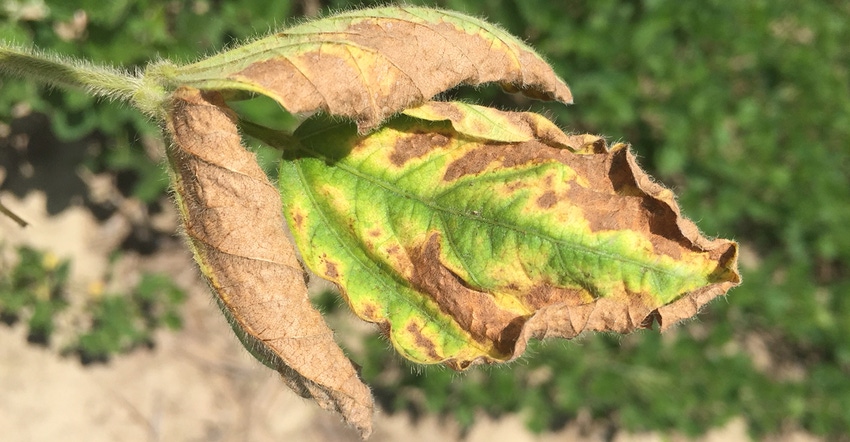
If you’ve noticed scattered soybean plants wilting or turning brown in your fields, you’re not alone. Agronomists like Steve Gauck have received many calls from growers noticing this phenomenon. Gauck is a Beck’s sales agronomist based near Greensburg, Ind., who also scouts the Soybean Watch ’18 field. Beck’s sponsors Soybean Watch ’18.
Gauck discovered that many of the symptoms farmers were seeing were caused by fusarium wilt. It’s by no means a new disease, but it doesn’t show up every year. In fact, it seldom causes significant yield losses by itself. It’s not even included in the soybean scouting calendar in the Purdue University Corn & Soybean Field Guide.
Why this year?
Midwest university sources indicate the organism that causes fusarium wilt in soybeans is common in the soil. It often affects plants in years when a reasonably long dry period is followed by a rainy period.
“That is what happened this year in many locations,” Gauck says. “It went dry in late May, and that continued into June. Then rains returned in many areas. That’s likely why we’re getting reports of the disease and finding it in fields.”
Fusarium wilt can infect soybean plants when they’re younger and then show up later in the season, Gauck says. University researchers who have studied the disease recommend looking for it through the R6 reproductive stage of soybeans, which is when beans are nearly mature.
Some seed treatments are effective against the disease. However, seed treatments don’t last for the entire season, Gauck notes. Fusarium wilt was found in some fields where treated seed was planted with a treatment that should control it. Gauck speculates that the seed treatment was no longer at full strength when the organism infected plants.
Identifying the disease
It’s possible to confuse fusarium wilt with phytophthora root rot until you look more closely, Gauck says. “We’ve actually seen a bit of phytophthora here and there, too,” he adds.
In early June, Gauck found a few plants in the Soybean Watch ’18 field that appeared to be affected by phytophthora. It was near the end of a dry period, but before rains returned. Phytophthora is normally associated with wet soils, but can also show up where soils are compacted or in other locations, especially if it’s warm. Gauck suspects very warm conditions in late May and early June may have contributed to a few instances of the disease, even where soils weren’t saturated.
When you compare plants infected by phytophthora and fusarium wilt side by side, plants with phytophthora will be discolored from the ground level working up the stem, Gauck says. Fusarium wilt typically doesn’t discolor stems. Roots will likely be rotted off with fusarium wilt.
If you split the stem open on a plant infected with fusarium wilt, it will likely be turning brown inside, appearing somewhat like brown stem rot. When phytophthora-infected stems are split open, they may be water-soaked, but won’t be brown.
Leaves of plants with fusarium wilt also sometimes resemble sudden death syndrome, with chlorosis between veins, Gauck adds.
About the Author(s)
You May Also Like




